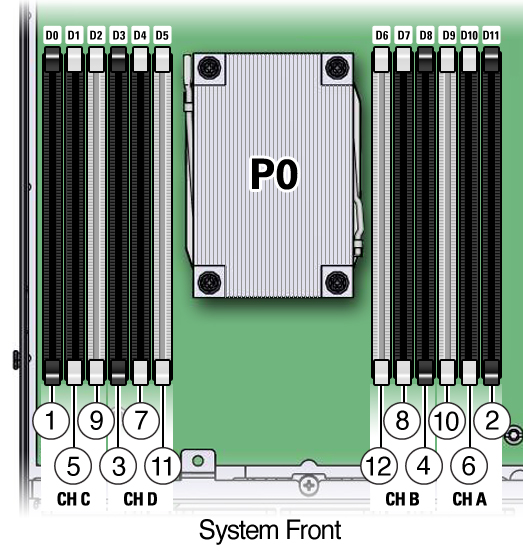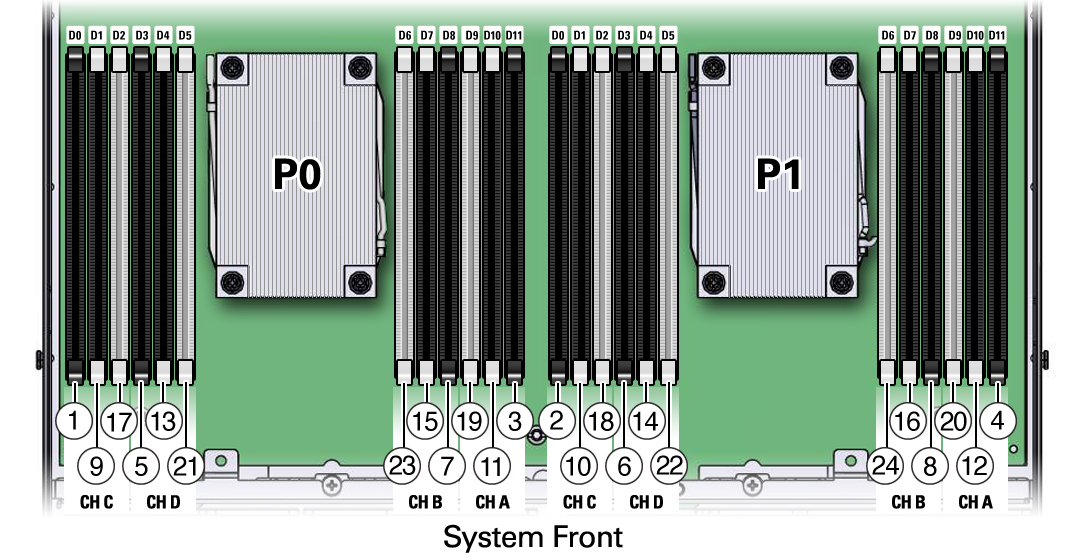Populating DIMMs for Optimal System Performance
Optimal performance is achieved by populating the DIMMs so that the memory is symmetrical, or balanced. Symmetry is achieved by adhering to the following guidelines:
-
In single-processor systems, populate DIMMs of the same size in multiples of four.
-
In dual-processor systems. populate DIMMs of the same size in multiples of eight.
-
Populate the DIMM sockets in the order described in the following sections.
The following sections provide an example of how to populate the DIMM sockets to achieve optimal system performance.
Note - Not all possible configurations are shown here.
-
Populating DIMMs in Single-Processor Systems for Optimal System Performance
-
Populating DIMMs in Dual-Processor Systems for Optimal System Performance
Populating DIMMs in Single-Processor Systems for Optimal System Performance
In single-processor systems, install DIMMs only into DIMM sockets associated with processor 0 (P0). Starting with socket P0 D0. Fill the black sockets first, then the black sockets with white tabs, and then the white sockets, as shown in the following figure. Notice that the order of populating the black sockets is Ch C first, Ch A second, Ch D third, and Ch B last. Repeat the same population sequence for the black sockets with white tabs, and finally for the white sockets.
Figure 3 DIMM Population Order for Single-Processor Systems

The following table describes the proper order in which to populate DIMMs in a single-processor system using the numbered callouts in the above figure, the memory channel labels (Ch A through Ch D), and the DIMM socket labels (D0 through D11).
|
Populating DIMMs in Dual-Processor Systems for Optimal System Performance
In dual-processor systems, populate DIMMs into DIMM sockets starting with processor 0 (P0) D0, then, alternating between sockets associated with processor 0 (P0) and matching sockets for processor 1 (P1). Fill the black sockets first, then the black sockets with white tabs, and then the white sockets, as shown in the following figure. Notice that the order of populating the black DIMM sockets is Ch C first, Ch A second, Ch D third, and Ch B last. Repeat the same population sequence for the black sockets with white tabs, and finally, for the white sockets.
Figure 4 DIMM Population Order for Dual-Processor Systems

The following table describes the proper order in which to install DIMMs in a dual-processor system using the numbered callouts in the above figure, the memory channels labels (Ch A through Ch D), and the DIMM socket labels (D0 through D11).
|